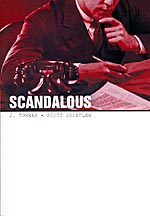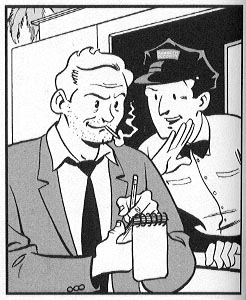 Written by J. Torres
Written by J. Torres
Art by Scott Chantler
104 pages, black and white
Published by Oni Press
J. Torres and Scott Chantler’s first collaboration was Days Like This, chronicling the rise of a singing group in the 1960s. It was a fun, fresh project that made me really want to see what they’d do together next. Now, a year and a half later, the wait is over: Scandalous, focusing on 1950s Hollywood. If it turned out to be as good as Days Like This, I’d be a happy reader indeed.
In 1950s Hollywood, there are two things which seem to hold sway over everything else: gossip, and the fear of Communism. (And of course, the second was commonly part of the first.) Gossip columnist Paige Turner holds sway over the movie-making community, trading stories for favors and making sure that every whisper on people’s lips was thanks to her. When a fact-checking private investigator named Harry Richards helps found a new rumor-spreading tabloid called Scandalous, though, it’s about to turn all of Hollywood’s underbelly upside down.
 Torres does a really good job of capturing what it was like to live in Hollywood during this time period, with the power that gossip of all shapes and sizes held over people’s lives. The “Red Scare” blacklisted and ran out numerous people in the industry, destroying many of their lives forever. Torres shows it for the terrifying force of nature that it was, rampaging through and dragging anyone who got too close down into oblivion. At the same time, Torres gives the appropriate focus to the other sort of gossip of the era, primarily focused on people’s love lives who were desperately trying to keep it out of the public eye. It’s a really crisp image of this part of history, and Torres’s story hits all of the marks perfectly. The one thing I wasn’t thrilled with, though, were Torres’s characters. The cast of Scandalous are primarily people that I really couldn’t care for; both Paige Turner and Harry Richards are ultimately people who make a living dredging up other people’s dirt and unleashing it on the rest of the world. Neither Paige nor Harry seem to really have a lot of scruples, and the more I read about them, the less I wanted to see them around. When the climax of Scandalous finally arrives, what should have been tense and exciting just had me unmoved thanks to the disdain that Torres managed to generate in me for his main characters. It’s a fine line to cross, having an unlikable protagonist that you still want to pay attention to, and for me it just didn’t quite connect.
Torres does a really good job of capturing what it was like to live in Hollywood during this time period, with the power that gossip of all shapes and sizes held over people’s lives. The “Red Scare” blacklisted and ran out numerous people in the industry, destroying many of their lives forever. Torres shows it for the terrifying force of nature that it was, rampaging through and dragging anyone who got too close down into oblivion. At the same time, Torres gives the appropriate focus to the other sort of gossip of the era, primarily focused on people’s love lives who were desperately trying to keep it out of the public eye. It’s a really crisp image of this part of history, and Torres’s story hits all of the marks perfectly. The one thing I wasn’t thrilled with, though, were Torres’s characters. The cast of Scandalous are primarily people that I really couldn’t care for; both Paige Turner and Harry Richards are ultimately people who make a living dredging up other people’s dirt and unleashing it on the rest of the world. Neither Paige nor Harry seem to really have a lot of scruples, and the more I read about them, the less I wanted to see them around. When the climax of Scandalous finally arrives, what should have been tense and exciting just had me unmoved thanks to the disdain that Torres managed to generate in me for his main characters. It’s a fine line to cross, having an unlikable protagonist that you still want to pay attention to, and for me it just didn’t quite connect.
Chantler’s art for Scandalous is up to its usual high standards, looking crisp and attractive on every page. His stripped down style reminds me a bit of classic animation, and that’s the perfect feel for a book like Scandalous. From Harry’s square jaw and stubbly chin to Paige’s scheming eyes and ostentateous hat, everyone truly looks the part that Torres needs them to play. People’s outfits look appropriate to their time period, Chantler paying close attention to detail to make sure that nothing in Scandalous is anachronistic. Even the grays work perfectly, using shading to bring the right level of contrast to the images. Chantler art was nice in Days Like This, but it’s even better here.
Scandalous is a book that doesn’t work perfectly, but its highs outweigh its weak spots. Chantler’s art is great, and the basic story that Torres is telling is interesting, especially thanks to Torres’s usage of the real societal enemies of the time period. I wish I could have liked the characters a bit more, but in many ways it’s the hazard for trying to tell this sort of story. Still, despite its flaw, I’m more than happy I took the time to read it. I’ll definitely be back for a third Torres and Chantler production.
Purchase Links:
